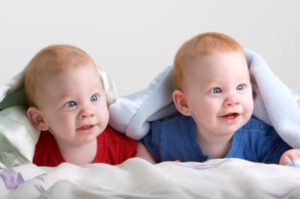In a recent paper, Southern California researchers announced that political involvement has a genetic component.
Though they stopped short of identifying a gene or genes at work, the researchers concluded that the decision to go out and vote was genetically determined by up to 50 percent. Genes, they also noted, were partially involved in other activities such as attending rallies, donating to a campaign, and even running for office.
UC San Diego professor James Fowler and his colleagues published their results in The American Political Science Review — not your typical genetics journal. They studied 396 same-sex twins, culled from a list of nearly four million registered voters in Los Angeles County, who had voted in eight state elections between 2000 and 2005. They then replicated their results using an independent twin population taken from the National Longitudinal Study of Adolescent Health.
Twin Study
Aside from finding identical twins more likely to vote the same way than fraternal twins, their data also suggested that genetics accounts for 53 percent of variance in going out to vote.
Fowler and his colleagues aren’t the only ones who use twin studies for their research. In a way, twins can provide researchers with perfectly matched test subjects and controls. Because identical twins have the same genetic information, for example, scientists can do one-on-one comparisons to find out why one is left-handed and the other right-handed, or why one has cancer but the other doesn’t. Such twin studies allow researchers to estimate how much of behavior is due to genes and how much can be attributed to environmental factors. They can also make such comparisons over larger groups of twins to look for a gene or genes that could explain these common traits.
Twin studies have indicated a genetic component underlying an amazing variety of traits, including:
- age-related hearing loss;
- neophobia, or aversion to new food;
- back pain;
- chronic fatigue syndrome;
- heart disease;
- nearsightedness;
- obsessive-compulsive disorder;
- the size of one’s brain; and,
- happiness.
Not So Fast
But not all researchers are impressed.
“We suggest that no scientific purpose is served by the flood of heritability estimates generated by these studies,” psychologist Leon J. Kamin and economist Arthur S. Goldberger wrote in a 2002 paper.
Kamin and Goldberger looked at two population samples used as the basis for several twin studies. One twin population known as MISTRA (Minnesota Study of Twins Reared Apart) is composed of identical twins separated early in life. Researchers wishing to study behavioral differences who used this group might think that any similarities between the twins would be genetic (attributed to nature) and any differences would then be due to environmental influences (nurture). However, Kamin and Goldberger found some cases where statements the twins had given indicated they might have compared notes prior to being interviewed. Such interactions, they argued, could skew the results in studies using MISTRA twins.
Other Studies
A second twin population is known as SATSA (Swedish Adoption/Twin Study of Aging). This sample is composed of four groups of twins: identical twins separated in childhood; identical twins reared together; fraternal twins separated before the age of 11; and fraternal twins reared together.
Kamin and Goldberger questioned the definition of separation as in some cases the twins were raised within the same extended family though they didn’t live in the same house. The environmental influences would be too similar, they argued, and that again could skew any conclusions reached by those conducting studies using these twin populations.
One twin study where researchers seem to have been able to successfully separate and track twins and multiples for years was conducted between 1953 and 1997. Known as the Child Development Center’s Study of Twins Reared Apart, the data are part of the records donated by lead researcher Peter Neubauer to Yale University, with the stipulation that the information remain sealed until 2066. For those unwilling to wait, some tidbits may be gleaned from a book by two of the study’s unknowing participants, Elyse Schein and Paula Bernstein, in their book Identical Strangers, as well as in Neubauer’s own book, Nature’s Thumbprint.



